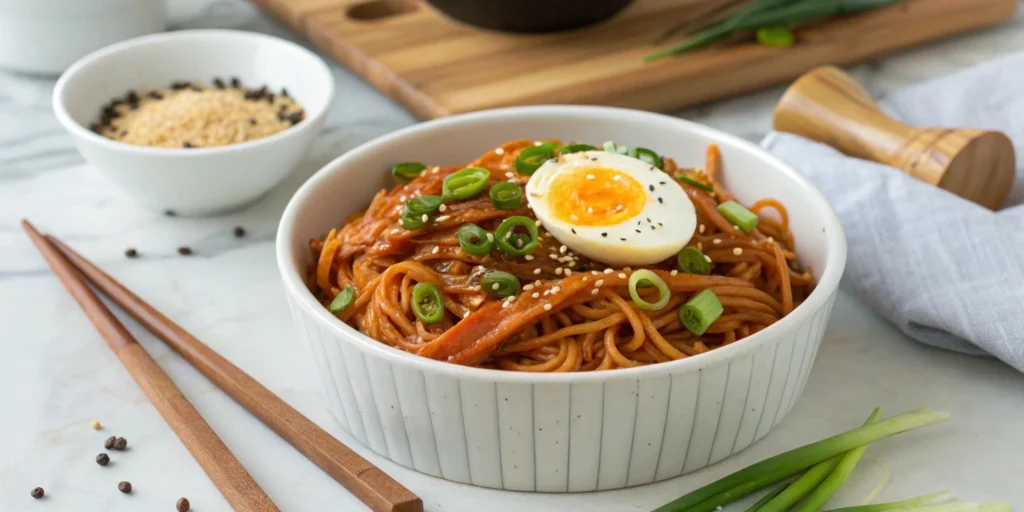
Table of Contents
Butter Gochujang Noodles: Your Ultimate 5-Minute Comfort Recipe
When you need a quick, soul-warming meal, few dishes can rival the bold simplicity of butter gochujang noodles. This Korean-inspired dish, known as 버터 고추장 국수 (beoteo gochujang guksu), combines the creamy decadence of butter with the fiery-sweet umami punch of gochujang, Korea’s iconic fermented chili paste. For me, this recipe is more than just a weeknight savior; it’s a connection to my roots. My grandmother’s recipe notebook, brimming with culinary wisdom, often guided me to whip up dishes like this, especially when time was short, and flavor was non-negotiable.
In just 5 minutes, you can craft a dish that bridges tradition and modern convenience. This is the recipe for anyone seeking bold flavors with minimal effort. Let’s explore how to make it, its benefits, and ways to make it uniquely yours.
What Are Butter Gochujang Noodles?
Butter gochujang noodles are a fusion dish that combines the smooth, velvety richness of melted butter with the dynamic spice and sweetness of gochujang. Originating from Korean culinary traditions but adapted for global kitchens, this dish highlights the versatility of gochujang. Its ability to marry spice, sweetness, and umami makes it a favorite ingredient for busy cooks craving bold flavors.
Whether you’re cooking for yourself or hosting friends, this recipe promises to impress without overwhelming you with complicated steps. All it takes is a handful of ingredients, many of which you might already have in your pantry.
Why This Recipe Works
This recipe is all about balance:
- Simplicity Meets Depth: Despite its minimal ingredient list, each component plays a crucial role in creating layers of flavor.
- Quick Cooking Time: Ready in under five minutes, it’s ideal for those moments when you’re short on time but still want something delicious.
- Customizable: You can adjust the spice level, add proteins, or include vegetables to suit your taste or dietary preferences.
Ingredients Breakdown
To make the perfect butter gochujang noodles, you’ll need:
Base Ingredients
- 200g noodles: Udon is my go-to for its chewiness, but spaghetti, soba, or even rice noodles work just as well.
- 2 tablespoons gochujang: This chili paste forms the backbone of the sauce, providing its signature heat and depth.
- 2 tablespoons unsalted butter: Adds creaminess and tempers the heat of the gochujang.
- 1 tablespoon soy sauce: Boosts umami and adds a touch of saltiness.
- 2 cloves garlic (minced): Infuses the dish with aromatic warmth.
Optional Toppings
- Green onions: A sprinkle of fresh green onions adds a burst of color and a mild, peppery flavor.
- Sesame seeds: A nutty, toasty crunch enhances the texture.
- Soft-boiled egg: The runny yolk blends beautifully into the sauce, adding richness.
Substitutions and Tips
- Butter Alternatives: For a dairy-free version, use vegan butter or olive oil.
- Gochujang Variations: Adjust the amount based on your spice tolerance. For a milder flavor, mix it with a little honey.
Step-by-Step Instructions
1. Prepare the Noodles
Boil your noodles in salted water until al dente. Udon typically takes 4-5 minutes, while spaghetti may take longer. Drain, rinse briefly with cold water, and set aside. Remember to save about ¼ cup of noodle water—it’s perfect for loosening the sauce later.
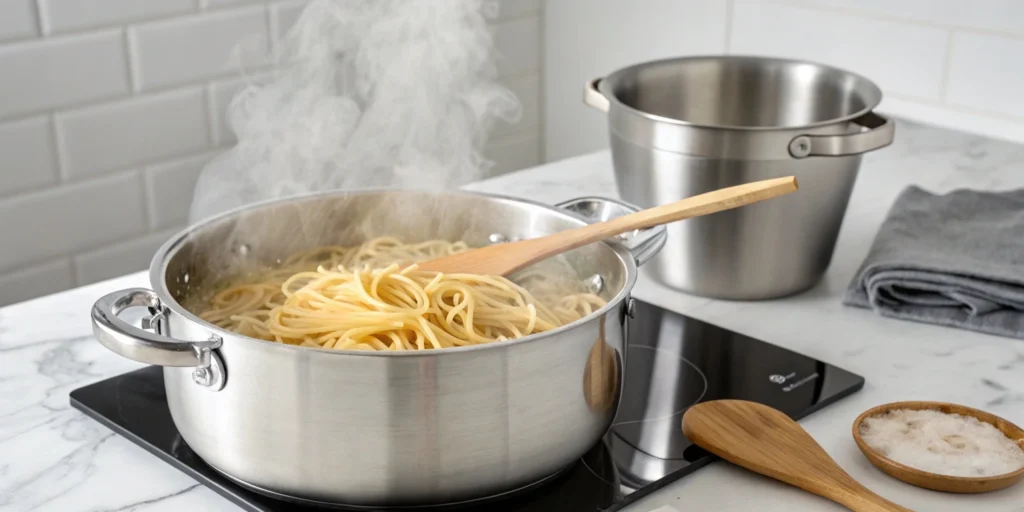
2. Create the Sauce
In a medium skillet, melt the butter on medium heat. Once it begins to bubble, add the minced garlic and sauté until fragrant, about 30 seconds. Stir in the gochujang and soy sauce, mixing until the ingredients form a smooth, glossy sauce.
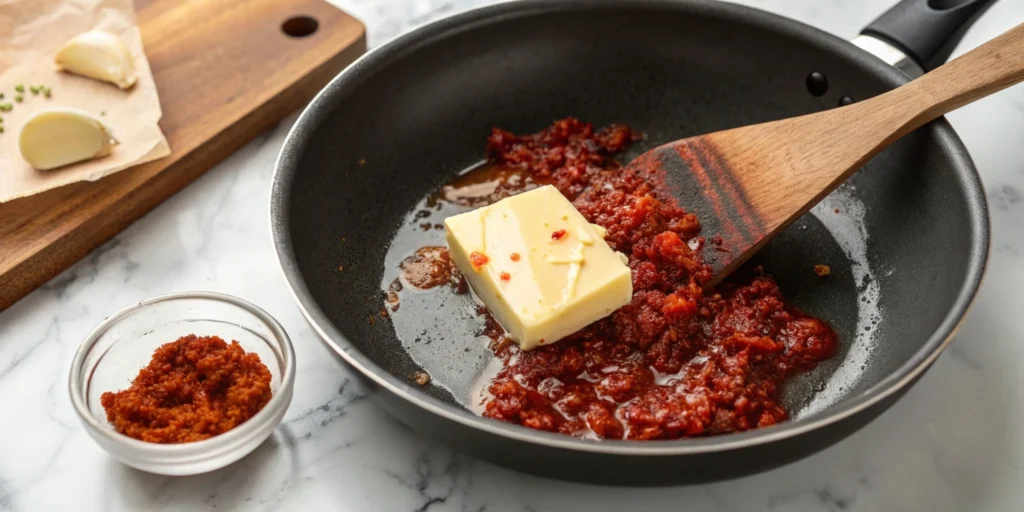
3. Combine the Noodles and Sauce
Reduce the heat to low, then toss the cooked noodles into the skillet. Stir until every strand is coated in the luscious red sauce. If the mixture feels too thick, add a tablespoon or two of the reserved noodle water to achieve your desired consistency.
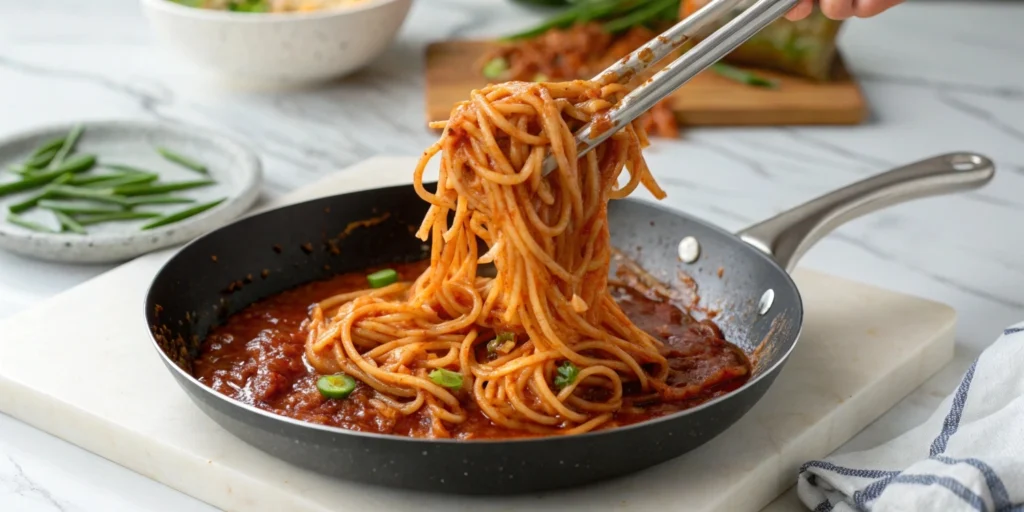
4. Plate and Garnish
Transfer the noodles to a bowl or plate. Garnish with your favorite toppings like green onions, sesame seeds, or a soft-boiled egg. Serve immediately and savor the fusion of flavors.
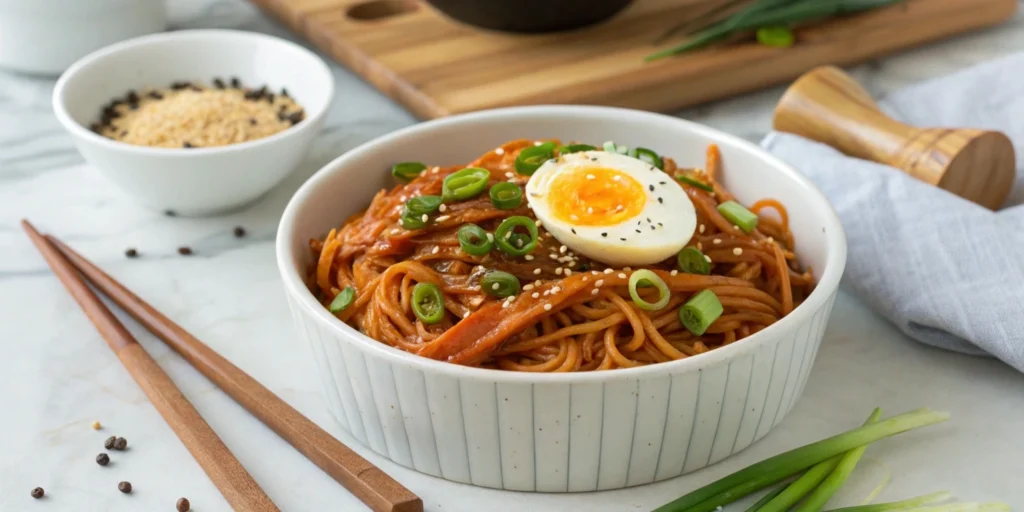
Nutritional Insights
Butter gochujang noodles aren’t just delicious; they can also be a well-rounded meal.
- Gochujang: This chili paste is packed with probiotics due to its fermentation process, which supports gut health. It also contains capsaicin, known for its metabolism-boosting properties.
- Butter: Provides healthy fats that enhance the dish’s satiety, keeping you full longer.
- Garlic: Rich in antioxidants and known for its immune-boosting benefits.
For a more nutrient-dense version, consider adding lean proteins or fresh vegetables to the dish.
Creative Twists and Variations
One of the best things about butter gochujang noodles is their versatility. Here are several ways to customize the dish:
Protein Additions
- Grilled Chicken: Adds a smoky depth that pairs wonderfully with the sauce.
- Shrimp: A quick-searing of shrimp makes the dish feel restaurant-worthy.
- Tofu: For a plant-based option, pan-fry tofu cubes and toss them in the sauce.
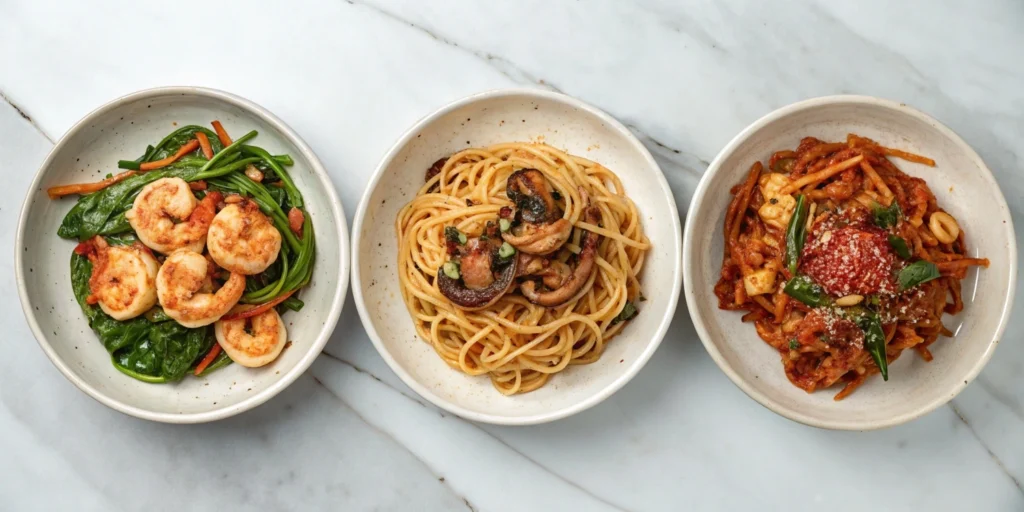
Vegetable Boosts
- Mushrooms: Sautéed shiitake or button mushrooms enhance the umami.
- Spinach or Bok Choy: A handful of greens can be wilted right into the hot noodles.
- Kimchi: A scoop of kimchi stirred into the noodles adds a tangy, fermented kick.
Textural Add-Ons
- Crunchy Toppings: Crushed peanuts or crispy shallots offer a satisfying crunch.
- Cheesy Finish: A sprinkle of grated Parmesan adds an unexpected twist.
Tips for Perfect Butter Gochujang Noodles
- Don’t Overcook the Noodles: Al dente noodles hold up better against the rich sauce.
- Adjust Spice Levels Gradually: Start with less gochujang and add more as needed.
- Use Fresh Ingredients: Fresh garlic and butter make a noticeable difference in flavor.
Frequently Asked Questions (FAQ)
1. Is this dish suitable for kids?
If your kids enjoy mild spice, you can reduce the gochujang to one tablespoon and balance it with a teaspoon of honey.
2. How can I store leftovers?
Keep leftovers in a sealed container in the fridge for up to three days. To reheat, warm them in a pan with a little water or broth to restore the sauce’s consistency.
3. Can I make this gluten-free?
Absolutely! Use gluten-free noodles and substitute tamari for soy sauce.
4. Where can I buy gochujang?
You can find gochujang at most Asian grocery stores or online. Look for brands like Chung Jung One or CJ Haechandle for authentic flavors.
Conclusion: A Dish Worth Making Again and Again
Butter gochujang noodles are more than just a recipe—they’re an experience. From the spicy tang of gochujang to the buttery richness that ties it all together, every bite is a celebration of flavor. It’s a dish that respects tradition while embracing modern simplicity, perfect for busy days or when you want to impress without the stress.
So why wait? Grab your ingredients and dive into the world of butter gochujang noodles. Don’t forget to share your version with family and friends—it’s a dish that sparks joy and satisfies cravings like no other.
Ready to elevate your noodle game? Let this recipe be your guide to effortless culinary bliss.
If you’d like additional tips or have questions about this recipe, leave a comment below. I’d love to hear your thoughts!
